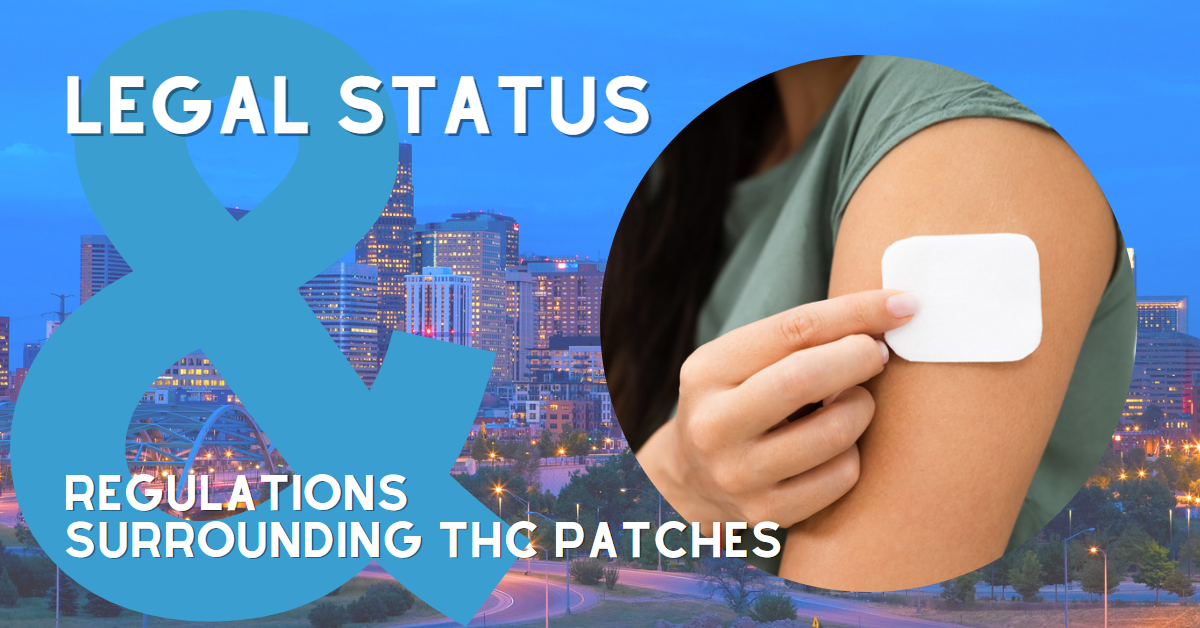
This website is for users aged 21 and over. Please confirm your age.

The health outcomes of long-term or heavy use of cannabis, without monitoring by health experts, can damage an individual’s mental and physical health. In this section, we will be looking into two potential solutions for this issue. Potency capping can be an efficient tool for preventing harmful consumption, while potency-based taxes may be a way to incentivize moderate THC consumption. THC Patches are the new kid on the block, and consumers need to know the legal status and regulations surrounding THC Patches.
Conversations about cannabis use have shifted to how it can be done responsibly and safely. One of the main ideas is potency capping, which means limiting the amount of THC in products. This prevents people from using too much and has harmful health effects.
Potency capping can be done in several ways. Regulating THC per product encourages producers to make low-dose options, making high-potency products less attractive. Plus, taxes based on potency can get consumers to choose lower-potency products that are suitable for public health and generate revenue.
Potency capping also helps stop people from becoming tolerant of marijuana. It sets a limit on how much THC each product can contain, making sure that people don’t take too much. This tool is especially effective as it works before any harm can occur.
In conclusion, potency capping is a great way to ensure that cannabis is used responsibly and without harm.
Potency-based taxes are a great way to push moderate THC consumption in the cannabis industry. This is done by taxing products based on their potency, thus encouraging people to choose lower-THC versions. This reduces the risks of bad health outcomes and promotes responsible use.
This approach also brings extra revenue for governments to support public health initiatives and research. Businesses have a chance to stand out by offering low-potency products.
It is necessary to ensure taxes don’t hurt medical cannabis users who need higher-potency items for their treatment. Regulations should be fair and not limit access to medicines.
Seed-to-sale tracking systems and purchasing rules must be implemented to make these taxes and regulations work. This will help public health research and promote responsible use.
Overall, a holistic approach that balances responsible use and public health is essential, and potency-based taxes are one strategy to do this.
The lack of promotion for moderation in cannabis use is a concerning issue, especially with the high rate of excessive purchases. In this section, we will discuss the role of regulation in promoting responsible use, backed by facts and figures from the reference data provided.
Regulations are a must to ensure responsible cannabis use. Excessive buying can have harmful long-term effects on health. To motivate moderate THC use, potency-based taxes can be introduced. This will stop consumers from buying more than needed. Capping THC present in cannabis products can also avoid overconsumption.
To keep purchases in check, Seed-to-Sale tracking systems can be employed. These systems provide data for public health research and identify potential issues with excessive buying.
Regulations should prioritize responsible use, protect public health and give legal access to cannabis. Educational programs that teach moderation and responsible behavior among consumers can decrease the prevalence of excessive purchases. And can help to minimize adverse health outcomes due to long-term or heavy use.
A Seed-to-Sale Tracking System is necessary for enforcing policies and improving public health research in the cannabis industry. It tracks cannabis products from cultivation to sale. This ensures all products are labeled, tested, and appropriately packaged to stop risks to public health.
Using the system, policymakers can manage the industry’s entire supply chain. This includes cultivation, processing, and distribution. They make sure cannabis products follow legislative regulations.
The system can also track the products’ potency, quality, and chemical consistency. This gives policymakers and researchers valuable data. They use this data to create new and better policies for the industry. It improves public health outcomes related to cannabis consumption. Researchers use the same data to determine the potential health risks and benefits of consuming cannabis products. This helps even more with public health outcomes.
The Seed-to-Sale Tracking System is a must-have for ensuring the cannabis industry follows legislative regulations. It also provides reliable data for public health research. Using the system, policymakers and researchers make informed decisions to better the industry and improve public health.
With the increasing demand for alternative ways to consume cannabis, the cannabis industry has seen the emergence of THC patches. However, these patches’ lack of regulation and potential side effects have raised concerns. In this section, we will explore the current state of regulation and look at the potential risks associated with using cannabis patches.
Cannabis or transdermal THC patches have sparked controversy due to their possible side effects and lack of regulations. These small adhesive patches release cannabinoids through the skin over a long period.
Users risk skin irritation and allergic reactions and may experience anxiety, psychosis, and mental health issues. The lack of regulation surrounding production and sale could contribute to these risks.
Manufacturers, regulators, and healthcare providers must collaborate to raise quality control standards for cannabis patch products. This includes testing, labeling, and inspections.
Policymakers must consider all sides when deciding the legality of cannabis patches in different states. More resources should be invested in enforcing existing regulations and remaining open to changes with research.
In conclusion, cannabis patches may represent the future of marijuana consumption; however, their legal status is uncertain due to side effects and lack of regulation. Everyone involved must work together to ensure they are safe and legally available.
In the United States, laws surrounding cannabis products are constantly changing. In this section, we’ll explore the legal status of cannabis patches specifically and delve into their availability in states where marijuana has been legalized. Let’s look closer at where THC patches stand in the ever-shifting landscape of cannabis regulations.
In particular US states, the legalization of marijuana has caused cannabis patches to become more available. These patches apply THC directly to the bloodstream, meaning no inhalation or digestion is needed. As acceptance of medical and recreational marijuana rises, so does the need for alternative ways of consuming it – beyond smoking or edibles.
Cannabis patches have gained a reputation as a discreet and regulated way to take THC. However, even in legal states, there may be regulations regarding them. Sometimes, only licensed dispensaries can sell them. Or specific delivery systems may be prohibited.
It’s essential to remember that laws and regulations about cannabis products can be different from state to state. So, staying up-to-date on what’s legal and available in your area is essential. Even though cannabis patches may be available in legal states, this doesn’t mean they’re everywhere. Be careful when getting them online or through unregulated retailers is best.
Also, legal restrictions remain in the US despite the 2018 Farm Bill bringing changes to hemp cultivation and distribution.
After passing the 2018 Farm Bill, cannabis regulations were significantly altered in the United States. This directly impacted various fields, including the burgeoning market for THC patches. In this section, we will explore the effects of the 2018 Farm Bill on the legal status and regulations surrounding THC patches. We will delve into the sub-sections of hemp cultivation and transfer under the bill and the current legal restrictions on hemp in the United States.
The 2018 Farm Bill has significantly adjusted how hemp farming and transferring is regulated in the US. A significant change is laws concerning hemp, removed from the list of controlled substances, permitting states to set up hemp plans without federal interference. This sparked hemp cultivation and transfer activities.
Farmers and businesses in hemp production still have to obey stringent rules from the 2018 Farm Bill. They must maintain a record of all steps in the production and circulation chain, ensuring traceability from seed to sale. They must also explain how they cultivate, harvest, test, and dispose of their crops.
The law also limits the THC levels that can be grown under the legislation. Industrial hemp must contain less than 0.3% Delta-9 tetrahydrocannabinol (THC). Farmers must get licenses from their state’s Department of Agriculture or other regulatory bodies to grow industrial hemp.
Due to the Farm Bill, research has grown to create new strains with high CBD yields and low THC concentrations for medicinal use. CBD is not psychoactive like THC, making it an excellent therapeutic option.
The legal restrictions that held back the cannabis industry in the US have been a challenge to regulate and support the responsible use of cannabis products. However, the 2018 Farm Bill has helped the hemp industry take a significant step forward to becoming a legitimate and regulated market.
Hemp has faced legal limitations in the U.S. since the 70s. But today’s laws are different. The 2018 Farm Bill states that hemp is any part of Cannabis sativa with less than 0.3% THC—this legalized cultivation and selling of hemp across the U.S.
However, there are still rules. Growers need licenses from their state’s agriculture department. In addition, each state may have its hemp policies.
To help farmers with these regulations, the U.S. Department of Agriculture created new tests for hemp THC levels. This testing is necessary to follow federal rules.
In summary, hemp is legal federally, but there are still restrictions on its growth and distribution. Knowing both federal and state laws is essential for hemp producers and sellers.
The popularity of THC patches is on the rise. So, regulations to encourage safe usage and protect public health must be implemented. The article “The Legal Status and Regulations Surrounding THC Patches” discusses possible regulations, such as labeling requirements, dosage limits, and age limits for buyers.
Labeling requirements should be clear and precise. Showing THC content, as well as potential side effects, is essential. To avoid overdosing, dosage limits should be set. Age limits also must be established to stop underage use and abuse.
The pros and cons of THC patches must be considered when making regulations. Though they offer relief for medical issues, misuse can lead to side effects and risks. So, regulations must consider both the benefits and risks of THC patches.
Everyone involved must stay informed on regulations to avoid legal issues and protect public health. All stakeholders must work together to ensure THC patches are used responsibly and effectively.
THC patches are transdermal patch that delivers a specific dose of THC (tetrahydrocannabinol), the primary psychoactive compound in cannabis, through the skin and into the bloodstream.
Due to federal laws, THC patches are not legally available for purchase in the United States. However, CBD patches are allowed for medical purposes in some states but are not considered a form of medical marijuana in most states.
The 2018 Farm Bill allows for broad hemp cultivation, not just pilot programs, and enables the transfer of hemp-derived products across state lines for commercial or other purposes. Hemp is legal in the United States but with controlled restrictions. Hemp is defined in the legislation as the cannabis plant with less than 0.3% THC and cannot get you high.
All states allow purchases exceeding 500 doses assuming a standardized ‘dose’ of 10 milligrams of THC for average-potency cannabis products, which does not promote moderation in use. However, Vermont and Connecticut are the only states that cap the potency of THC on most cannabis products. Therefore, making this a valuable tool for preventing harmful consumption.
Taxes based on potency rather than price or weight can incentivize moderate THC consumption.
The FDA does not regulate cannabis patches.
We warmly welcome you to explore our highly acclaimed strains, concentrates, and edibles. Serving recreational clients with pride is our passion.
At our dispensary, you'll find a professional yet inviting atmosphere that prioritizes your comfort and privacy. Feel free to stop by at your earliest convenience to experience it for yourself. We can't wait to serve you!


